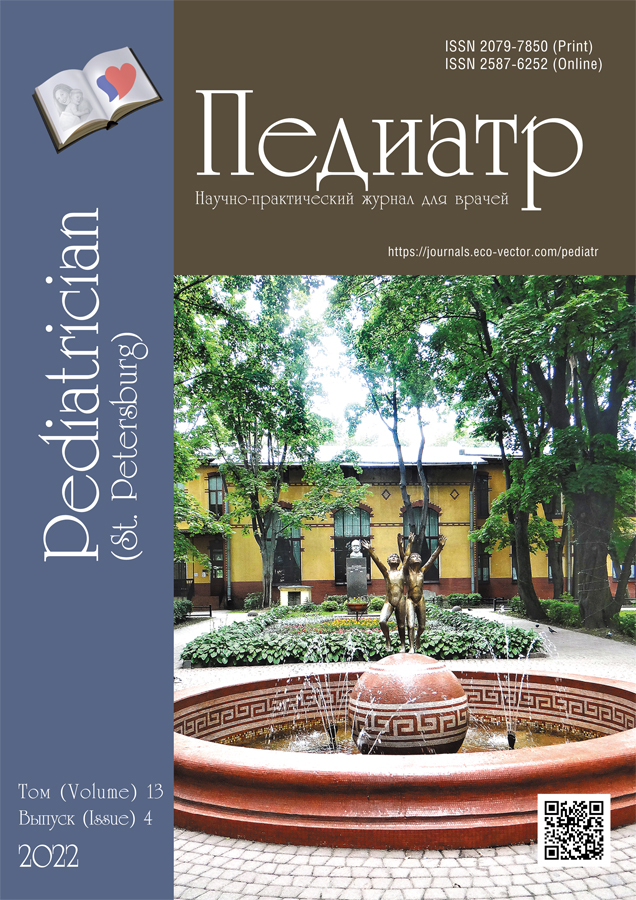Клинический случай успешной коррекции коарктации аорты с гипоплазией дистальной дуги аорты у недоношенного ребенка с очень низкой массой тела при рождении
- Авторы: Базылев В.В.1, Чупров М.П.1, Щеглова К.Т.1, Бофанов Д.А.1, Щеглов С.Е.1
-
Учреждения:
- Федеральный центр сердечно-сосудистой хирургии
- Выпуск: Том 13, № 4 (2022)
- Страницы: 101-106
- Раздел: Клинический случай
- URL: https://journals.eco-vector.com/pediatr/article/view/114941
- DOI: https://doi.org/10.17816/PED134101-106
- ID: 114941
Цитировать
Аннотация
Врожденный порок сердца считается одним из наиболее частых среди врожденных пороков при рождении. Коарктация аорты относится к группе часто встречающихся врожденных пороков сердца. В подавляющем большинстве случаев она сочетается с гипоплазией дуги аорты и требует неотложного хирургического вмешательства. Отсутствие своевременной диагностики данной патологии и необходимой терапии приведет к застойной сердечной недостаточности, кардиогенному шоку и смерти. Хотя результаты лечения новорожденных с врожденными пороками сердца значительно улучшились за последние годы, дети с низкой массой тела остаются сложной категорией больных. Недоношенность и низкий вес при рождении — факторы риска повышенной смертности и развития рекоарктации у младенцев, перенесших хирургическую коррекцию.
Представлен клинический случай успешной коррекции коарктации аорты с гипоплазией дистальной дуги аорты у недоношенного ребенка с очень низкой массой тела при рождении. Диагноз установлен пренатально. Матери рекомендовано наблюдение в перинатальном центре Пензы, где на 35-й неделе выполнено досрочное родоразрешение по поводу маловодия и внутриутробной задержки развития плода. Масса тела при рождении составила 1330 г. В этот же день ребенок поступил в Федеральный центр сердечно-сосудистой хирургии Пензы, где получил необходимую хирургическую помощь. Результаты динамического наблюдения за пациентом показывают отсутствие рекоарктации и артериальной гипертензии.
Несмотря на то что низкая масса тела и недоношенность считаются значимыми факторами риска развития осложнений и неблагоприятного исхода, современные медицинские технологии и накопленный опыт позволили своевременно выполнить хирургическую коррекцию и провести успешное послеоперационное лечение и выхаживание ребенка с коарктацией и гипоплазией дуги аорты.
Полный текст
Об авторах
Владлен Владленович Базылев
Федеральный центр сердечно-сосудистой хирургии
Email: cardio58@yandex.ru
д-р. мед. наук, профессор, главный врач
Россия, ПензаМаксим Петрович Чупров
Федеральный центр сердечно-сосудистой хирургии
Автор, ответственный за переписку.
Email: maks13chup@bk.ru
канд. мед. наук, врач-реаниматолог, отделение реанимации и интенсивной терапии
Россия, ПензаКлара Тамирлановна Щеглова
Федеральный центр сердечно-сосудистой хирургии
Email: klaratamir@yandex.ru
врач-реаниматолог, отделение реанимации и интенсивной терапии
Россия, ПензаДмитрий Алексеевич Бофанов
Федеральный центр сердечно-сосудистой хирургии
Email: bofanov83@mail.ru
врач сердечно-сосудистый хирург, кардиохирургическое отделение № 2
Россия, ПензаСавелий Евгеньевич Щеглов
Федеральный центр сердечно-сосудистой хирургии
Email: SShcheglov22@yandex.ru
врач-реаниматолог, отделение реанимации и интенсивной терапии
Россия, ПензаСписок литературы
- Борисков М. В., Петшаковский П. Ю., Серова Т.В. Коарктация аорты у новорожденных. Современное состояние проблемы // Инновационная медицина Кубани. 2016. № 3. С. 66–72.
- Грехов Е.В., Морозов А.А., Латыпов А.К., и др. Модифицированная пластика дистального сегмента дуги аорты с использованием тканей левой общей сонной артерии у новорожденного с предуктальной коарктацией аорты и гипоплазией дистальной дуги аорты в сочетании с атипичным течением мышечного дефекта межжелудочковой перегородки // Патология кровообращения и кардиохирургия. 2019. Т. 23, № 1. С. 71–77. DOI: 10.21688-1681-3472-2019-1-71-77.
- Сойнов И.А., Синельников Ю.С., Корнилов И.А., и др. Хирургическая коррекция коарктации аорты с гипоплазией дистальной дуги у пациентов раннего возраста // Патология кровообращения и кардиохирургия. 2016. Т. 20, № 2. С. 66–73. DOI: 10.21688-1681–3472-2016-2-66-73
- Ades A., Johnson B.A., Berger S. Management of low birth weight infants with congenital heart disease // Clin Perinatol. 2005. Vol. 32, No. 4. P. 999–1015. doi: 10.1016/j.clp.2005.09.001
- Dias M.Q., Barros A., Leite-Moreira A., Miranda J.O. Risk factors for recoarctation and mortality in infants submitted to aortic coarctation repair: a systematic review // Pediatr Cardiol. 2020. Vol. 41, No. 3. P. 561–575. doi: 10.1007/s00246-020-02319-w.
- Marelli A.J., Mackie A.S., Ionescu-Ittu R., et al. Congenital heart disease in the general population: changing prevalence and age distribution // Circulation. 2007. Vol. 115, No. 2. P. 163–172. doi: 10.1161/CIRCULATIONAHA.106.627224
- Norman M., Håkansson S., Kusuda S., et al. Neonatal outcomes in very preterm infants with severe congenital heart defects: an international cohort study // J Am Heart Assoc. 2020. Vol. 9, No. 5. ID e015369. doi: 10.1161/JAHA.119.015369
- Rakhra S.S., Lee M., Iyengar A.J., et al. Poor outcomes after surgery for coarctation repair with hypoplastic arch warrants more extensive initial surgery and close long-term follow-up // Interact Cardiovasc Thorac Surg. 2013. Vol. 16, No. 1. P. 31–36. doi: 10.1093/icvts/ivs301
- Tsang V., Haapanen H., Neijenhuis R. Aortic coarctation/arch hypoplasia repair: how small is too small // Seminars in Thoracic and Cardiovascular Surgery: Pediatric Cardiac Surgery Annual. 2019. Vol. 22. P. 10–13. doi: 10.1053/j.pcsu.2019.02.011
Дополнительные файлы










